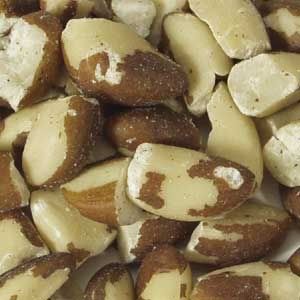I eat 2 of these a day everyday for a selenium source. Good idea? Better than chemical versions of selenium? They taste good too!

Brazil Nuts
Started by
boily
, Mar 07 2006 08:30 PM
8 replies to this topic
#1
Posted 07 March 2006 - 08:30 PM
I eat 2 of these a day everyday for a selenium source. Good idea? Better than chemical versions of selenium? They taste good too!
#2
Posted 08 March 2006 - 12:20 AM
A food source is always better. What exactly are these nuts? (post a link to an image please)
#3
Posted 08 March 2006 - 03:10 AM
Brazil nuts, Bertholletia excelsa. IMO, the natural forms of vitamins and minerals are almost always superior. It's just getting your RDA is very tough while eating just "food" (i.e no supplements), and keeping calories/fats/carbs at reasonable levels is near impossible in order to fulfil those needs without supps.




#4
Posted 08 March 2006 - 06:48 PM
Brazil nuts are good, but most of the selenium is in forms that can become toxic if you eat a lot at once. I eat organic garlic and onions as a selenium source and take 200-400 mcg of se-methylselenocysteine. AOR, LEF and VRP have articles on this form of selenium. I suggest you read up; it's a pretty amazing supp from an anti-cancer cost/benefit point of view.
#5
Posted 09 March 2006 - 10:21 AM
Does it also have uric acid?
#6
Posted 09 March 2006 - 04:11 PM
Uhm, I didnt study enought about selenium 
Now I did some research.
L-selenomethionine and se-methylselenocysteine are the only two good forms of selenium to take. And as you said, the second is better for cancer prevention at 3-400mg.
http://www.selenomet...msupplement.pdf
Now I did some research.
L-selenomethionine and se-methylselenocysteine are the only two good forms of selenium to take. And as you said, the second is better for cancer prevention at 3-400mg.
http://www.selenomet...msupplement.pdf
#7
Posted 10 March 2006 - 12:02 PM
This is from the wholehealthmd.com
http://www.wholeheal...523,115,00.html
Brazil nuts are nutrient-dense, which means that, in relation to their size, they contain a wide variety of nutrients. Brazil nuts, in fact, are chock full of significant nutrients, including protein, fiber, selenium, magnesium, phosphorous, and thiamin (there is also a decent amount of niacin, vitamin E, vitamin B6, calcium, iron, potassium, zinc, and copper). Brazil nuts are also a source of arginine (an amino acid that plays a role in blood clot formation) and flavonoids--important antioxidant compounds believed to be protective against both coronary disease and cancer.
While it is true that Brazil nuts are high in fat, the fat is mostly unsaturated, the type of fat that has been associated with lowering cholesterol. The large crescent-shaped kernels contain alpha-linolenic acid, which converts to omega-3 fatty acids in the body; it is the omega-3 fatty acids which scientists feel may reduce the risk of heart disease.
Brazil nuts are actually large seeds of giant trees that grow in the Amazon jungle. These extraordinary nuts are shaped like triangular orange segments, are extremely hard, and are found in clusters of 12 to 24 inside a 4" to 6" pod that resembles a coconut (a botanical definition of a nut is a fruit with a hard, dry shell that needs to be cracked open to release the kernel). The pods are gathered when they have fallen from the trees and they must be chopped open to obtain the nuts. Falling Brazil nut tree pods can be dangerous, and Indians who gather the pods make sure to do so in clement weather.
A mature tree can produce between 250 and 500 pounds of Brazil nuts per year. Brazil nut trees do not begin to produce nuts in significant quantities until after about 12 to 15 years. The majestic Brazil nut tree grows wild in the tropical rain forests, and most attempts to cultivate it elsewhere have been unsuccessful. Although thousands of tons of Brazil nuts are exported each year from Brazil, almost all of Brazil nut production is a result of wild forest trees and wild harvesting.
Brazil nuts taste sweet and rich, and their meat is similar in texture to coconut. These nuts can be eaten raw, roasted, salted, and in various dessert items such as ice cream, confectionery, and baked goods.
Brazil Nuts/1 ounce
Calories 186
Total fat (g) 19
Saturated fat (g) 4.6
Monounsaturated fat (g) 6.5
Polyunsaturated fat (g) 6.8
Dietary fiber (g) 1.5
Protein (g) 4
Carbohydrate (g) 4
Cholesterol (mg) 0
Sodium (mg) 1
Thiamin (mg) 0.3
Copper (mg) 0.5
Magnesium (mg) 64
Phosphorus (mg) 170
Selenium (mcg) 839
Looks to be a lot of nutrition in these nuts! Ben
http://www.wholeheal...523,115,00.html
Brazil nuts are nutrient-dense, which means that, in relation to their size, they contain a wide variety of nutrients. Brazil nuts, in fact, are chock full of significant nutrients, including protein, fiber, selenium, magnesium, phosphorous, and thiamin (there is also a decent amount of niacin, vitamin E, vitamin B6, calcium, iron, potassium, zinc, and copper). Brazil nuts are also a source of arginine (an amino acid that plays a role in blood clot formation) and flavonoids--important antioxidant compounds believed to be protective against both coronary disease and cancer.
While it is true that Brazil nuts are high in fat, the fat is mostly unsaturated, the type of fat that has been associated with lowering cholesterol. The large crescent-shaped kernels contain alpha-linolenic acid, which converts to omega-3 fatty acids in the body; it is the omega-3 fatty acids which scientists feel may reduce the risk of heart disease.
Brazil nuts are actually large seeds of giant trees that grow in the Amazon jungle. These extraordinary nuts are shaped like triangular orange segments, are extremely hard, and are found in clusters of 12 to 24 inside a 4" to 6" pod that resembles a coconut (a botanical definition of a nut is a fruit with a hard, dry shell that needs to be cracked open to release the kernel). The pods are gathered when they have fallen from the trees and they must be chopped open to obtain the nuts. Falling Brazil nut tree pods can be dangerous, and Indians who gather the pods make sure to do so in clement weather.
A mature tree can produce between 250 and 500 pounds of Brazil nuts per year. Brazil nut trees do not begin to produce nuts in significant quantities until after about 12 to 15 years. The majestic Brazil nut tree grows wild in the tropical rain forests, and most attempts to cultivate it elsewhere have been unsuccessful. Although thousands of tons of Brazil nuts are exported each year from Brazil, almost all of Brazil nut production is a result of wild forest trees and wild harvesting.
Brazil nuts taste sweet and rich, and their meat is similar in texture to coconut. These nuts can be eaten raw, roasted, salted, and in various dessert items such as ice cream, confectionery, and baked goods.
Brazil Nuts/1 ounce
Calories 186
Total fat (g) 19
Saturated fat (g) 4.6
Monounsaturated fat (g) 6.5
Polyunsaturated fat (g) 6.8
Dietary fiber (g) 1.5
Protein (g) 4
Carbohydrate (g) 4
Cholesterol (mg) 0
Sodium (mg) 1
Thiamin (mg) 0.3
Copper (mg) 0.5
Magnesium (mg) 64
Phosphorus (mg) 170
Selenium (mcg) 839
Looks to be a lot of nutrition in these nuts! Ben
#8
Posted 10 March 2006 - 04:20 PM
Here's a professor at the university i was attending who has an interesting article on the HIV/AIDS-selenium connection:
http://www.hdfoster.com/
http://www.hdfoster.com/
#9
Posted 10 March 2006 - 05:59 PM
hmm interesting read anyway.
1 user(s) are reading this topic
0 members, 1 guests, 0 anonymous users














































